Featured
China at the 2024 Paralympics: Golds, Champions, and Trending Moments
China’s standout moments, trending topics, and social media buzz from the 2024 Paralympics in Paris.
Published
10 months agoon
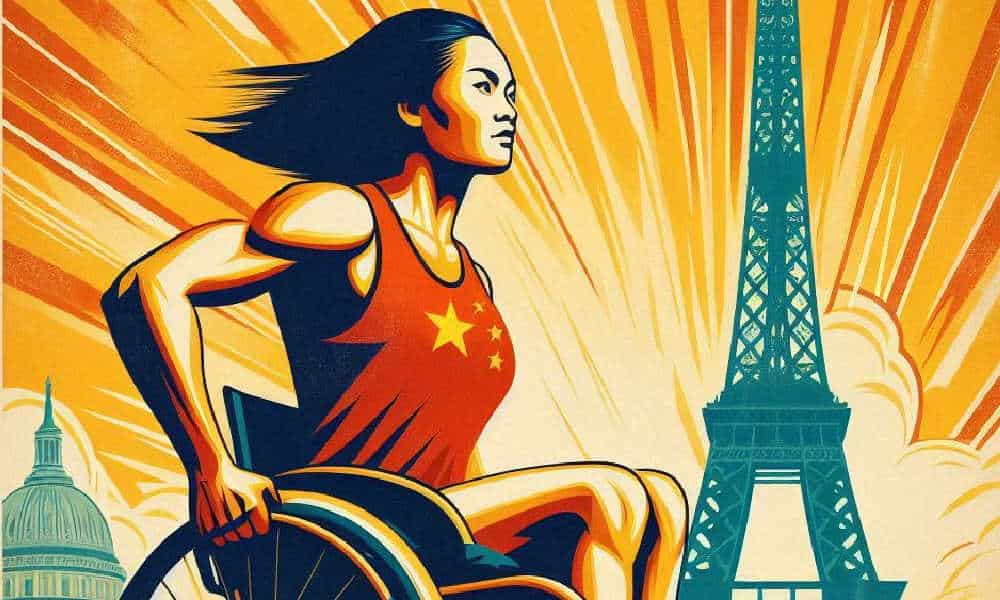
This article was first published by What’s on Weibo on
This is a ‘dynamic file’ offering updates on trending topics and buzz related to China’s participation in the 2024 Paralympics in Paris.
After China’s golden success at the 2024 Paris Olympics, it’s time for the Paralympics (残奥会) from 28 August 2024 – 8 September 2024. Although not as popular as the Olympics, the start of the Paralympics was still a popular topic on Chinese social media, with the topic hitting the top trending lists on August 28-29.
China has sent a delegation of 284 athletes—126 men and 158 women—to compete in 302 events across 19 sports. For 95 of these athletes, it’s their Paralympic debut.
This article is a ‘live file’ to track the various relevant hashtags and discussions on Chinese social media surrounding the events. If you don’t see any current updates, refresh the page or check back a day later to see new additions.
August 28
🔹 Celebrating the Start of the Paralympics
The opening ceremony of the 2024 Paralympics on August 28 took place at the Place de la Concorde, featuring 500 performers and a parade celebrating the 128 competing nations.
The Chinese delegation was led by two flag bearers: female wheelchair fencer Gu Haiyan (辜海燕) and male weightlifter Qi Yongkai (齐勇凯).
What particularly attracted attention on Chinese social media is how the renowned actor and martial arts hero Jackie Chan participated in the Paralympic torch relay (#成龙传递巴黎残奥会火炬#). He carried the Paralympic flame through the city, and also found some time to pose for selfies. People seemed to especially appreciate how popular Jackie Chan is, not just in China but also among fans abroad. This even made it to the number one trending topic on Chinese short video app Kuaishou.
August 29
🔹 China’s First Paralympic Gold
🥇 The first gold of the 2024 Paralympics for China was won by para-cyclist Li Zhangyu (李樟煜) in the Men’s 3000 m Pursuit. Beyond winning gold, he also broke a world record, smashing the previous record by crossing the line in a time of 3’31”338, 11 seconds faster than his compatriot Liang Weicong (梁伟聪), who finished with a time of 3’42”468 and took the silver medal.
For the 36-year-old Li, this marks his fifth Paralympic gold. He previously won the 3000m Individual Pursuit event at Rio 2016, and also earned a silver at London 2012 and a bronze at Tokyo 2020.

Chinese state media celebrating the first Paralympic gold.
Li Zhangyu was born in 1988 in Nanshan Village, Zhejiang. Diagnosed with cerebral palsy as a child, he had difficulty walking and often fell. To help him, his father bought him a small bicycle at the age of five or six. This marked the beginning of Li’s cycling journey, which would eventually lead him to become a historic Paralympic champion.
🔹 China’s Second Paralympic Gold
🥇 Wang Xiaomei (王小梅) became the second Paralympic athlete to win gold for China in the women’s C1-3 3000m individual pursuit.
The 24-year-old athlete from Yunnan’s Dali set a new world record in the women’s C3 3000m individual pursuit with a time of 3:44.660. In the final, where she claimed gold, she broke the world record again with a time of 3:41.692.

Wang Xiaomei has congenital cerebral palsy, which primarily affects the right side of her body. Cycling has significantly improved her physical condition. She is widely recognized as an inspiration for the way she has faced her challenges and persevered, which has led her to where she is today.
🔹 Two Swimming Gold
August 29 also marked the start of the swimming events, with 46 athletes from the Chinese team participating.
🥇🥇 Chinese swimmer Chen Yi (陈怡) secured gold in the women’s 50m freestyle S10, while Jiang Yuyan (蒋裕燕) claimed gold in the women’s 50m freestyle S6.
As a result, on the first day of the Paralympic events, the Chinese sports delegation earned a total of 4 gold medals and 1 silver medal.
August 30
🔹 Zhou Xia’s Three-Time Gold
🥇 Chinese para-athlete Zhou Xia (周霞) grabbed another gold for China on Friday. In the women’s T35 100m final, she claimed her medal with a season-best time of 13.58 seconds.
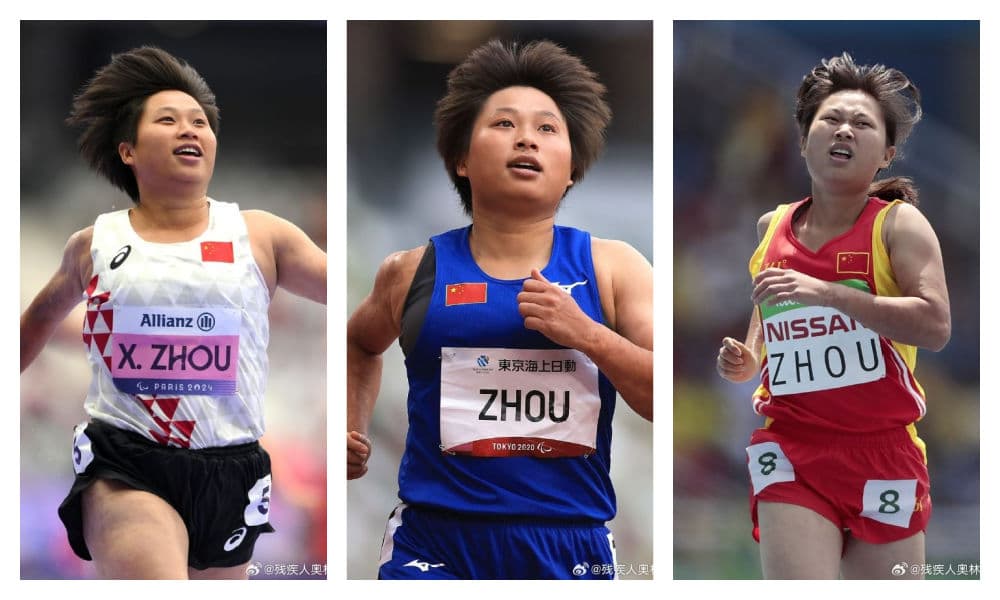
Zhou in Paris (left), Tokyo (middle) and Rio (right).
For Zhou, it’s her third Olympic success; she previously also grabbed gold in Rio and Tokyo. Zhou suffers from muscular atrophy in her left leg and left hand due to a car accident.
🔹 Yang Hong’s World Record
🥇 It seems that China is breaking many world records at this Paralympics. The 24-year-old Yang Hong (杨洪) clinched the gold medal in the Para Swimming Men’s 200m Individual Medley at the La Défense Arena in Paris.

August 31
🔹 China Going Strong: 20 Gold Medals on Day Three
On the third day of the Paralympics, Team China is going at full speed, as its gold medal count is already up to 20! This also includes a few athletes who grabbed gold on the 30th.
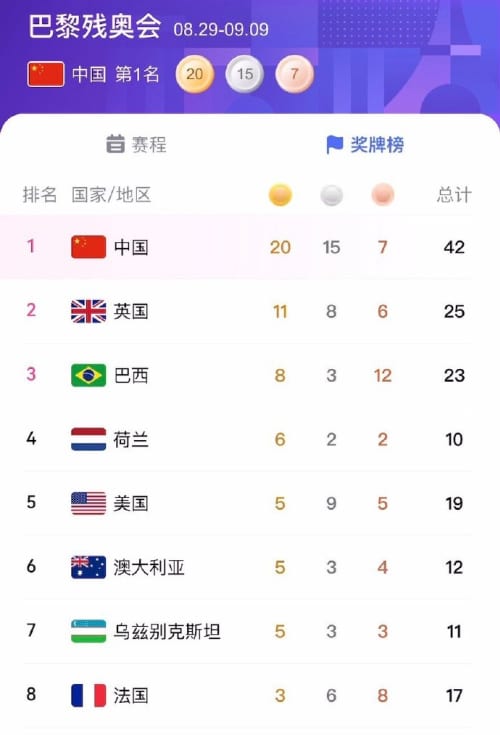
With 42 medals in total, China is topping the Olympic ranking.
September 1
🔹 “The Paralympics Are About the Limits of the Mind”
How does the general Chinese audience feel about the Paralympics? On Weibo and other platforms, the event is generally receiving less attention that the Olympics, also because it generally is less popular, with less commercial value.
Nevertheless, many people do follow the Paralympics and are impressed by the athletes. “The Olympics are about the limits of the body, the Paralympics are about the limits of the mind,” one Weibo user wrote.
Another Weibo blogger wrote: “The level of attention for the Paralympic events is still very low. It would be great if they could go trending a bit more. I bet many people don’t even know that the Paralympics take place after the Olympics. There’s only one gold medal for each event, but all those who participate in the Paralympic Games are heroes, winners, and champions in their own lives!”
September 2
🔹 From Small Village to Para Archery Gold
🥇 Zhang Tianxin (张天鑫), from a small village in Jiaxing, claimed gold in the Mixed Team W1 Para Archery event on September 2, alongside teammate Chen Minyi (陈敏仪). The pair defeated the Czech team. This victory comes shortly after Zhang also secured a bronze medal on September 1.
Having started archery in 2017, Zhang previously won gold at both the Tokyo Paralympics and the Hangzhou Asian Para Games.
On social media, his achievements are celebrated by Pinghu, the county-level city in Jiaxing where Zhang’s hometown, Shanqinggang village, is located. Pinghu also created a special film featuring Zhang, highlighting the strength of Para athletes.
September 4
🔹 The First gold for Henan: Wang Jingang
🥇 On September 4, Henan athlete Wang Jingang (王金刚) won the gold medal in the men’s 50m butterfly S6 final at the Paris Paralympics with a time of 31.24 seconds. This victory was celebrated on social media as it marked Henan’s first Paralympic gold. Henan is not typically among the top-performing provinces in the Olympics.

Wang Jingang (王金刚) taking the first Paralympic gold for Henan. Image via Zhengzhou Weibo account @郑州发布.
At the Paris Olympics, Chinese athletes from Guangdong Province won the most medals, followed by those from Shanghai, Shandong, Zhejiang, and Jiangsu.
It’s notable that during the Paralympics, even more than the Olympics, athletes’ hometowns are enthusiastically celebrating their Paris medals. Their achievements are viewed not just as national victories, but as local triumphs, bringing pride and joy to their communities.
This is evident in places like Henan, celebrating Wang Jingang, and Pinghu, honoring Zhang Tianxin, among many others. Rather than being solely seen as national heroes, these Para athletes are embraced as regional champions.
🔹 Who is four-time Paralympic champion Jiang Yuyan?
🥇 Jiang Yuyan (蒋裕燕) is one of the most discussed and popular Paralympic champions in China these days. She is also nicknamed the “Flying Fish with Broken Wings” (折翼飞鱼).
The Zhejiang-born athlete first claimed gold in Para Swimming in the women’s 50m freestyle, then went on to win another gold in the 50m butterfly. She added a third gold in the mixed event and secured a fourth on September 4th in the women’s 100m freestyle.
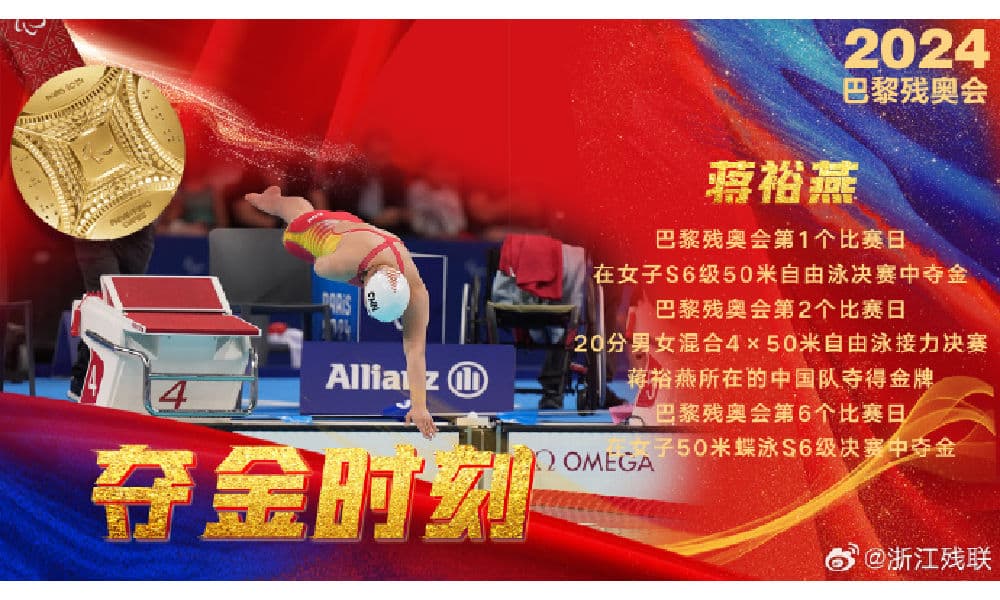
Jiang celebrated by Chinese official accounts.
Jiang began her professional athletic career in 2017, competing in national para events as part of the provincial team. She reportedly trains for at least six hours a day, with a key focus on maintaining balance, as she is missing her right arm and right leg.
As a preschooler, Jiang was involved in a car accident that resulted in the loss of her right hand and leg. To prevent muscle atrophy and aid her recovery, her mother enrolled her in a summer swimming class.

From the moment she entered the water, Jiang fell in love with swimming. She told reporters: “Fish have a tail, and I have a leg. In the water, I can enjoy freedom.”
September 5
🔹 Blind Soccer
While everyone’s focused on China’s national soccer team losing 0-7 to Japan in the 2026 World Cup Asian qualifiers, there’s a more successful story in Chinese soccer. China’s Blind Soccer team triumphed 1-0 against Morocco at the Paralympics, a victory that continues to be celebrated online despite the national team’s loss to Japan.
September 6
🔹 China’s Paralympic Success
With two days left before the end of the Paralympics, China is far ahead in the medal rankings with 186 medals, including 82 gold. The UK, in second place, lags behind with 100 medals, of which 42 are gold.
For both the Olympics and Paralympics, much of China’s sports success is often viewed by looking back at how far the country has come since it first participated in 1984.
In the Paralympics, China’s winning streak has continued since 2012, when Team China first took the top position.
Although China has seen great success in the Paralympics, and much like the Olympics, this success is tied to its rise on the global stage. However, it hasn’t led to more discussion on systemic issues around disability. The focus remains more on individuals overcoming challenges rather than addressing broader issues.[1]
—————————
End
—————————
By Manya Koetse
[1] Also see: Liu Yang & Zhongxuan Lin (2023) The national hero, the supercrip, and the self-reliant figure: Paralympic champions on China Central Television’s sports channel, Sport in Society, 26:9, 1477-1491, DOI: 10.1080/17430437.2022.2147064
Spotted a mistake or want to add something? Please let us know in comments below or email us. First-time commenters, please be patient – we will have to manually approve your comment before it appears.
©2024 Whatsonweibo. All rights reserved. Do not reproduce our content without permission – you can contact us at info@whatsonweibo.com.
Manya is the founder and editor-in-chief of What's on Weibo, offering independent analysis of social trends, online media, and digital culture in China for over a decade. Subscribe to gain access to content, including the Weibo Watch newsletter, which provides deeper insights into the China trends that matter. More about Manya at manyakoetse.com or follow on X.
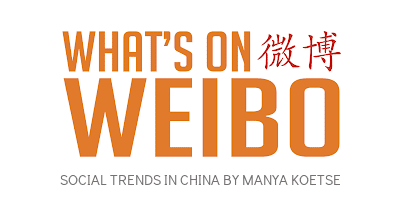
China ACG Culture
A Very Short Guide to China’s Most Popular Designer Toys
Published
1 week agoon
July 6, 2025
In our last article, we’ve determined how Wakuku’s rise is not just about copying & following in Labubu’s footsteps and more about how China is setting the pace for global pop culture IPs. I now want to give you a small peek into the main characters in the field that are currently relevant.
Even if these dolls aren’t really your thing, you’ll inevitably run into them and everything happening around them.
Before diving into the top trending characters, a quick word on the challenges ahead for Labubu & co:
🚩 Bloomberg Opinion columnist Shuli Ren recently argued that Labubu’s biggest threat isn’t competition from Wakuku or knockoffs like “Lafufu,” but the fragility of its resale ecosystem — particularly how POP MART balances supply, scarcity, and reseller control.
Scarcity is part of what makes Labubu feel premium. But if too many dolls go to scalpers, it alienates real fans. If scalpers can’t profit, Labubu risks losing its luxury edge. Managing this dynamic may be POP MART’s greatest long-term challenge.
🚩 Chinese Gen Z consumers value authenticity — and that’s something money can’t manufacture. If China’s booming IP toy industry prioritizes speed and profit over soul, the hype may die out at a certain point.
🚩 The same goes for storytelling. Characters need a solid universe to grow in. Labubu had years to build out its fantasy universe. Cute alone isn’t enough — characterless toys don’t leave a lasting impression and don’t resonate with consumers.

Examples of popularity rankings of Chinese IP toys on Xiaohongshu.
With that in mind… let’s meet the main players.
On platforms like Xiaohongshu, Douyin, and Weibo, users regularly rank the hottest collectible IPs. Based on those rankings, here’s a quick who’s-who of China’s current trend toy universe:

1. Labubu (拉布布)
Brand: POP MART
Creator: Kasing Lung
Year launched: 2015 (independent), 2019 with POP MART.
The undisputed icon of China’s trend toy world, Labubu is a mischievous Nordic forest troll with big eyes, nine pointy teeth, and bunny ears. Its quirky, ugly-cute design, endless possibilities of DIY costume changes, and viral celebrity endorsements have made it a must-have collectible and a global pop culture phenomenon.

2. Wakuku (哇库库)
Brand & Creator: Letsvan, backed by QuantaSing Group
Year launched: 2024 with first blind box
Wakuku, a “tribal jungle hunter” with a cheeky grin and unibrow, is seen as the rising star in China’s trend toy market. Wakuku’s rapid rise is fueled by celebrity marketing, pop-up launches, and its strong appeal among Gen Z, especially considering Wakuku is more affordable than Labubu.

3. Molly (茉莉)
Brand: POP MART
Designer: Kenny Wong (王信明)
Year launched: 2006 (creator concept); POP MART 2014, first blind boxes in 2016
Molly is a classic trend toy IP, one of POP MART’s favorites, with a massive fanbase and long-lasting popularity. The character was allegedly inspired by a chance encounter with a determined young kid at a charity fundraiser event, after which Kenny Wong created Molly as a blue-eyed girl with short hair, a bit of a temperament, and an iconic pouting expression that never leaves her face.

4. SKULLPANDA (骷髅熊猫)
Brand: POP MART
Creator: Chinese designer Xiong Miao
Year launched: 2018 (creator concept); POP MART 2020
Skullpanda is one of POP MART’s flagship IPs —it’s a goth-inspired fantasy design. According to POP MART, SKULLPANDA journeys through different worlds, taking on various personas and living out myriad lives. On this grand adventure, it’s on a quest to find its truest self and break new ground all while contemplating the shape of infinity.
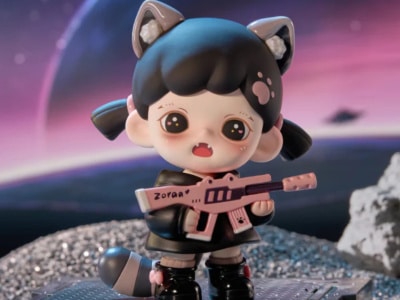
5. Baby Zoraa
Brand: TNT SPACE
Creator: Wang Zequn, CEO of TNT SPACE
Year launched: 2022, same year as company launch
Baby Zoraa is cute yet devlish fierce and is one of the most popular IPs under TNT SPACE. Baby Zoraa is the sister of Boy Rayan, another popular character under the same brand. Baby Zoraa’s first blind box edition reached #1 on Tmall’s trend toy sales charts and sold over 500,000 units.

6. Dora (大表姐)
Brand: TNT SPACE
Year Launched: 2023
Dora is a cool, rebellious “big sister” figure, instantly recognizable for her bold attitude and expressive style. She’s a Gen Z favorite for her gender-fluid, empowering persona, and became a breakout sucess under TNT when it launched its bigger blind boxes in 2023.

7. Twinkle Twinkle [Star Man] (星星人)
Brand: POP MART
Creator: Illustrators Daxin and Ali
Year launched: In 2024 with POP MART
This character has recently skyrocketed in popularity as a “healing star character” inspired by how stars shine even in darkness. POP MART markets this character as being full of innocence and fantasy to provide some relaxation in this modern society full of busyness and pressure.

8. Hirono (小野)
Brand: POP MART
Creator: Lang
Year launched: In 2024 with POP MART
This freckled, perpetually grumpy boy has a wild spirit combining introversion and playful defiance. Hirono highlights the subtle fluctuations of life, its ups and downs, incorporating joy, sadness, fear, and more – a personification of profound human emotions.

9. Crybaby (哭娃)
Brand: POP MART
Creator: Thai artist Molly Yllom (aka Nisa “Mod” Srikamdee)
Year launched: 2017 (creator concept), 2023 POP MART launch
Like Wakuku, Crybaby suddenly went from a niche IP to a new hot trend toy in 2025. Together with Wakuku, it is called the “next Labubu.” Thai artist Molly Yllom created the character after the loss of her beloved dog. Crybaby is a symbol of emotional expression, particularly the idea that it’s okay to cry and express feelings.

10. Pouka Pouka (波卡波卡)
Brand: 52TOYS
Creator: Ma Xiaoben
Year launched: 2025
With its round, chubby face, squirrel cheeks, playful smile, and soft, comforting appearance, Pouka Pouka aims to evoke feelings of warmth, healing, and emotional comfort.
Other characters to watch: CiciLu, Panda Roll (胖哒幼), NANCI (囡茜), FARMER BOB (农夫鲍勃), Rayan, Ozai (哦崽), Lulu the Piggy (LuLu猪), Pucky (毕奇).
We’re still working on this list!
By Manya Koetse
(follow on X, LinkedIn, or Instagram)
Spotted a mistake or want to add something? Please let us know in comments below or email us. First-time commenters, please be patient – we will have to manually approve your comment before it appears.
©2025 Whatsonweibo. All rights reserved. Do not reproduce our content without permission – you can contact us at info@whatsonweibo.com.
China ACG Culture
The Next Labubu: What the Rise of Wakuku Tells Us About China’s Collectible Toy Wave
From ugly-cute rebellion to a new kind of ‘C-pop,’ the breakout success of Wakuku sheds light on Chinese consumer culture and the forces driving China’s trend toy industry.
Published
1 week agoon
July 6, 2025
Wakuku is the most talked-about newcomer in China’s trend toy market. Besides its mischievous grin, what’s perhaps most noteworthy is how closely Wakuku follows the marketing success of Labubu. As the strongest new designer toy of 2025, Wakuku says a lot about China’s current creative economy — from youth-led consumer trends to hybrid business models.
As it is becoming increasingly clear that Chinese designer toy Labubu has basically conquered the world, it’s already time for the next made-in-China collectible toy to start trending on Chinese social media.
Now, the name that’s trending is Wakuku, a Chinese trend toy created by the Shenzhen-based company Letsvan.
In March 2025, a new panda-inspired Wakuku debuted at Miniso Land in Beijing, immediately breaking records and boosting overall store revenue by over 90%. Wakuku also broke daily sales records on May 17 with the launch of its “Fox-and-Bunny” collab at Miniso flagship stores in Shanghai and Nanjing. At the opening of the Miniso Space in Nanjing on June 18, another Wakuku figure sold out within just two hours. Over the past week, Wakuku went trending on Chinese social media multiple times.

From left to right: the March, May, and June successful Wakuku series/figurines
Like Labubu, Wakuku is a collectible keychain doll with a soft vinyl face and a plush body. These designer toys are especially popular among Chinese Gen Z female consumers, who use them as fashion accessories (hanging them from bags) or as desk companions.
We previously wrote in depth about the birth of Labubu, its launch by the Chinese POP MART (founded 2010), and the recipe for its global popularity in this article, so if you’re new to this trend of Chinese designer toys, you’ll want to check it out first (link).
Labubu has been making international headlines for months now, with the hype reaching a new peak when a human-sized Labubu sold for a record 1.08 million RMB (US$150,700), followed by a special edition that was purchased for nearly 760,000 RMB (US$106,000).
Now, Wakuku is the new kid on the block, and while it took Labubu nine years to win over young Chinese consumers, it barely took Wakuku a year — the character was created in 2022–2023, made its retail debut in 2024, and went viral within months.
Its pricing is affordable (59–159 RMB, around $8.2-$22) and some netizens argue it’s more quality for money.
While Labubu is a Nordic forest elf, Wakuku is a tribal jungle warrior. It comes in various designs and colors depending on the series and is sold in blind boxes (盲盒), meaning buyers don’t know exactly which design they’re getting — which adds an element of surprise.
➡️ There’s a lot to say about Wakuku, but perhaps the most noteworthy aspect is how closely it mirrors the trajectory of POP MART’s Labubu.
Wakuku’s recent success in China highlights the growing appeal and rapid rise of Chinese IPs (beyond its legal “intellectual property” meaning, ‘IPs’ is used to refer to unique cultural brands, characters, or stories that can be developed into collectibles, merchandise, and broader pop culture phenomena).
Although many critics predict that the Labubu trend will blow over soon, the popularity of Wakuku and other Labubu-like newcomers shows that these toys are not just a fleeting craze, but a cultural phenomenon that reflects the mindset of young Chinese consumers, China’s cross-industry business dynamics, and the global rise of a new kind of ‘C-pop.’
Wakuku: A Cheeky Jungle Copycat
When I say that Wakuku follows POP MART’s path almost exactly, I’m not exaggerating. Wakuku may be portrayed as a wild jungle child, but it’s definitely also a copycat.
It uses the same materials as Labubu (soft vinyl + plush), the name follows the same ABB format (Labubu, Wakuku, and the panda-themed Wakuku Pangdada), and the character story is built on a similar fantasy universe.
In fact, Letsvan’s very existence is tied to POP MART’s rise — the company was only founded in 2020, the same year POP MART, then already a decade old, went public on the Hong Kong Stock Exchange and became a dominant industry force.
In terms of marketing, Wakuku imitates POP MART’s strategy: blind boxes, well-timed viral drops, limited-edition tactics, and immersive retail environments.
It even follows a similar international expansion model as POP MART, turning Thailand into its first stop (出海首站) — not just because of its cultural proximity and flourishing Gen Z social media market, but also because Thailand was one of the first and most successful foreign markets for Labubu.
Its success is also deeply linked to celebrity endorsement. Just as Labubu gained global traction with icons like BLACKPINK’s Lisa and Rihanna seen holding the doll, Wakuku too leans heavily on celebrity visibility and entertainment culture.
Like Labubu, Wakuku even launched its own Wakuku theme song.
Since 2024, Letsvan has partnered with Yuehua Entertainment (乐华娱乐) — one of China’s leading talent agencies — to tap into its entertainment resources and celebrity network, powering the Wakuku marketing engine. Since stars like Esther Yu (虞书欣) were spotted wearing Wakuku as a jeans hanger, demand for the doll skyrocketed. Yuehua’s founder, Du Hua (杜华), even gifted a Wakuku to David Beckham as part of its celebrity strategy.

From Beckham to Esther Yu; celebrity endorsements play a big role in the viral marketing of Wakuku.
But what’s most important in Wakuku’s success — and how it builds on Labubu — is that it fully embraces the ugly-cute (丑萌 chǒu méng) aesthetic. Wakuku has a mischievous smile, expressive eyes, a slightly crooked face, a unibrow, and freckles — fitting perfectly with what many young Chinese consumers love: expressive, anti-perfectionist characters (反精致).
“Ugly-Cute” as an Aesthetic Rebellion
Letsvan is clearly riding the wave of “ugly trend toys” (丑萌潮玩) that POP MART spent years cultivating.
🔍 Why are Chinese youth so obsessed with things that look quirky or ugly?
A recent article by the Beijing Science Center (北京科学中心) highlights how “ugly-cute” toys like Labubu and Wakuku deviate from traditional Chinese aesthetics, and reflect a deeper generational pushback against perfection and societal expectations.
The pressure young people face — in education, at work, from family expectations, and information overload — is a red thread running through how China’s Gen Z behaves as a social media user and consumer (also see the last newsletter on nostalgia core).
To cope with daily stress, many turn to softer forms of resistance, such as the “lying flat” movement or the sluggish “rat lifestyle” in which people reject societal pressures to succeed, choosing instead to do the bare minimum and live simply.
This generational pushback also extends to traditional norms around marriage, gender roles, and ideals of beauty. Designer toys like Labubu and Wakuku are quirky, asymmetrical, gender-fluid, rebellious, and reflect a broader cultural shift: a playful rejection of conformity and a celebration of personal expression, authenticity, and self-acceptance.

Another popular designer toy is Crybaby, designed by Thai designer Molly, and described as follows: “Crybaby is not a boy or a girl, it is not even just human, it represents an emotion that comes from deep within. It can be anything and everything! Laughter isn’t the only way to make you feel better, crying can be healing too. If one day, a smile can’t alleviate your problems, baby, let’s cry together.”
But this isn’t just about rejecting tradition. It’s also about seeking happiness, comfort, and surprise: emotional value. And it’s usually not brand-focused but influencer-led. What matters is the story around it and who recommends it (unless the brand becomes the influencer itself — which is what’s ultimately happening with POP MART).
One of the unofficial ambassadors of the chǒu méng ugly-cute trend is Quan Hongchan (全红婵), the teenage diving champion and Olympic gold medallist from Guangdong. Quan is beloved not just for her talent, but also for her playful, down-to-earth personality.
During the Paris Olympics, she went viral for her backpack, which was overflowing with stuffed animals (some joked she was “carrying a zoo on her back”) — and for her animal-themed slippers, including a pair of ugly fish ones.

Quan Hongchan with her Wakuku, and her backpack and slippers during her Paris Olympics days.
It’s no surprise that Quan Hongchan is now also among the celebrities boosting the popularity of the quirky Wakuku.
From Factory to Fandom: A New Kind of “C-pop” in the Making
The success of Wakuku and other similar toys shows that they’re much more than Labubu 2.0; they’re all part of a broader trend tapping into the tastes and values of Chinese youth — which also speaks to a global audience.
And this trend is serious business. POP MART is one of the world’s fastest-growing consumer brands, with a current market value of approximately $43 billion, according to Morgan Stanley.
No wonder everyone wants a piece of the ‘Labubu pie,’ from small vendors to major companies.
It’s not just the resellers of authentic Labubu dolls who are profiting from the trend — so are the sellers of ‘Lafufu,’ a nickname for counterfeit Labubu dolls, that have become ubiquitous on e-commerce platforms and in toy markets (quite literally).
Wakuku’s rapid rise is also a story of calculated imitation. In this case, copying isn’t seen as a flaw but as smart market participation.
The founding team behind Letsvan already had a decade of experience in product design before setting out on their journey to become a major player in China’s popular designer toy and character merchandise market.
But their real breakthrough came in early 2025, when QuantaSing (量子之歌), a leading adult learning ed-tech company with no previous ties to toys, acquired a 61% stake in the company.
With QuantaSing’s financial backing, Yuehua Entertainment’s marketing power, and Miniso’s distribution reach, Wakuku took it to the next level.
The speed and precision with which Letsvan, QuantaSing, and Wakuku moved to monetize a subcultural trend — even before it fully peaked — shows just how advanced China’s trend toy industry has become.
This is no longer just about cute (or ugly-cute) designs; it’s about strategic ecosystems by ‘IP factories,’ from concept and design to manufacturing and distribution, blind-box scarcity tactics, immersive store experiences, and influencer-led viral campaigns — all part of a roadmap that POP MART refined and is now adopted by many others finding their way into this lucrative market. Their success is powered by the strength of China’s industrial & digital infrastructure, along with cross-industry collaboration.
The rise of Chinese designer toy companies reminds of the playbook of K-pop entertainment companies — with tight control over IP creation, strong visual branding, carefully engineered virality, and a deep understanding of fandom culture. (For more on this, see my earlier explanation of the K-pop success formula.)
If K-pop’s global impact is any indication, China’s designer toy IPs are only beginning to show their potential. The ecosystems forming around these products — from factory to fandom — signal that Labubu and Wakuku are just the first wave of a much larger movement.
– By Manya Koetse
Spotted a mistake or want to add something? Please let us know in comments below or email us. First-time commenters, please be patient – we will have to manually approve your comment before it appears.
©2025 Whatsonweibo. All rights reserved. Do not reproduce our content without permission – you can contact us at info@whatsonweibo.com.
Subscribe
What’s on Weibo is a reader-supported publication, run by Manya Koetse (@manyapan), offering independent analysis of social trends in China for over a decade. To receive new posts and support our work, consider becoming a paid subscriber.


A Very Short Guide to China’s Most Popular Designer Toys

The Next Labubu: What the Rise of Wakuku Tells Us About China’s Collectible Toy Wave

Jiehun Huazhai (结婚化债): Getting Married to Pay Off Debts

Yearnings, Dreamcore, and the Rise of AI Nostalgia in China

Beauty Influencer Du Meizhu Accused of Scamming Fan Out of $27K

China Is Not Censoring Its Social Media to Please the West

Inside the Labubu Craze and the Globalization of Chinese Designer Toys

China Reacts: 3 Trending Hashtags Shaping the Tariff War Narrative

China Trending Week 15/16: Gu Ming Viral Collab, Maozi & Meigui Fallout, Datong Post-Engagement Rape Case

Chinese New Nickname for Trump Mixes Fairy Tales with Tariff War

No Quiet Qingming: From High-Tech Tomb-Sweeping to IShowSpeed & the Seven China Streams

Understanding the Dr. Xiao Medical Scandal

Behind the Mysterious Death of Chinese Internet Celebrity Cat Wukong

Do You Know Who Li Gang Is? Anti-Corruption Official Arrested for Corruption

China’s Major Food Delivery Showdown: What to Know about the JD.com vs. Meituan Clash
Get in touch
Would you like to become a contributor, or do you have any tips or suggestions? Get in touch here!
Popular Reads
-

 China Society10 months ago
China Society10 months agoDeath of Chinese Female Motorcycle Influencer ‘Shigao ProMax’ Sparks Debate on Risky Rides for Online Attention
-

 China World11 months ago
China World11 months agoChina at Paris 2024 Olympics Trend File: Medals and Moments on Chinese Social Media
-

 China Memes & Viral11 months ago
China Memes & Viral11 months agoTeam China’s 10 Most Meme-Worthy Moments at the 2024 Paris Olympics
-
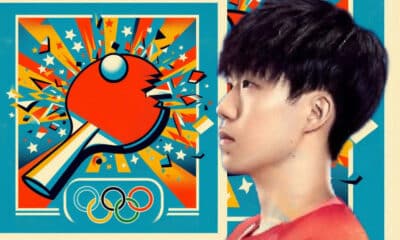
 China Memes & Viral12 months ago
China Memes & Viral12 months agoAbout Wang Chuqin’s Broken Paddle at Paris 2024



